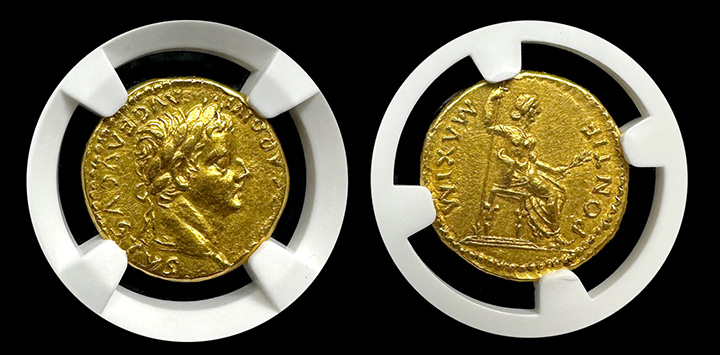
In history's annals, few figures are as enigmatic and influential as Roman Emperor Tiberius. Roman Emperor Tiberius's Legacy from AD 14 to 37 signified a vital era in the Roman Empire. Additionally, it was characterized by intricate politics, imperial ambitions, and a transformative period for Roman coinage.
Tiberius's path to the throne faced considerable challenges. He spent his early years as a soldier, gaining valuable military experience across Roman provinces. Unquestionably, his success in quelling revolts and vital roles in the Roman military paved his way to leadership.
Tiberius: The Man and the Emperor
In AD 4, Tiberius was recalled to Rome and named co-regent with Augustus. As a result of Augustus's AD 14 demise, Tiberius ascended the imperial throne. Consequently, he shaped the Roman Empire for over two decades.
Born Tiberius Julius Caesar, his life was rife with complexities. As the stepson of Augustus, the first Roman Emperor, he overcame numerous political obstacles to become the second Emperor. His reign was a tapestry of significant successes and challenges. Henceforth, it left historians pondering the complex character of the man who succeeded Augustus.
The Prudent Administrator
Tiberius is remembered as a wise and effective ruler of the Roman Empire, known for his capable administration. Although he inherited a thriving realm, stretching from Hispania to Egypt, he faced difficulties such as military campaigns and border security. Nonetheless, he's lauded for upholding stability in the empire.
The Coinage Reformer
It was not merely political acumen that distinguished Tiberius. His reign left an indelible mark on Roman coinage. Furthermore, it revealed a deep understanding of the symbolic power of currency. His aurei and denarii were not mere coins; they were instruments of statecraft.
Roman Emperor Tiberius's Legacy included Roman coinage undergoing a remarkable transformation. His coin imagery transitioned to reflect the values and aspirations of his governance. On the obverse, we encounter Tiberius's stern and dignified countenance, offering a tangible link to one of history's most formidable empires. However, flipping it reveals something extraordinary. The reverse features Livia as PAX, the embodiment of peace, narrating an emperor's aspirations for a harmonious and prosperous Rome. It's not just a coin; it's a historical treasure and artistic marvel.
Tiberius Gold Aureus
The Tiberius Gold Aureus encapsulates history and is an example of the transformed coinage. As mentioned before, the obverse features Tiberius's stern and dignified countenance. However, flipping it reveals Livia as PAX. It's not just a coin; it's a historical treasure and artistic marvel.
Tiberius's coinage reflects his vision and influence during his rule. The Tiberius Gold Aureus, in particular, is emblematic of his commitment to representing a united and harmonious empire. Its imagery tells a captivating story of an era where power, artistry, and history converged in small, meticulously crafted pieces of metal. These coins remain a testament to Tiberius's enduring legacy and his keen understanding of the power of symbols on currency.
The Power of Coin Imagery
It's vital to grasp the significance of these coin images. Roman coins were more than currency; they conveyed the Emperor's authority and ideals. Altogether, they bridged the Emperor with the diverse populace of the Roman Empire.
Continuing Legacy
Tiberius' influence on Roman coinage transcended his era. His use of imagery and symbolism set a precedent for future Emperors. In fact, the tradition of conveying political and cultural messages through coinage extended for centuries, reflecting various dynasties' ideals and aspirations.
Tiberius focused on military matters, and administrative reforms, and maintained a degree of reclusiveness during his reign. Like many emperors, his rule featured a blend of achievements and controversies. Yet, his influence on the Roman Empire's development is undeniable.
The Roman Empire in Tiberius's Era
During Tiberius's rule from AD 14 to 37, the Roman Empire was in a state of transition. It had transformed from the Roman Republic into the principate, under the rule of Augustus, Tiberius's predecessor. The Roman Empire, at its zenith, stretched from the British Isles to Egypt, from Spain to Mesopotamia. By comparison, it was a realm of immense diversity, where different cultures, languages, and belief systems intermingled.
Tiberius's reign was marked by administrative reforms and a focus on the Roman legions' readiness. While he is often viewed as a reserved and reclusive ruler, his rule had lasting implications for the Roman Empire. Indeed, both in its domestic and foreign affairs. One of his most well-known policies was the reinforcement of the Empire's borders and consolidation of its existing territories.
Conclusion
Roman Emperor Tiberius's Legacy, the enigmatic Roman Emperor, holds a unique place in history. His astute use of coinage as a political tool paved the way for the Emperor to communicate his vision to a vast empire. Tiberius left a legacy not just in his political achievements but in the enduring artistry of the coins he left behind. These small pieces of history continue to captivate the world, reminding us of the power of symbols on currency. The story of Tiberius and his coinage is a testament to the enduring nature of numismatics, a field where the past comes alive through meticulously crafted pieces of metal.
